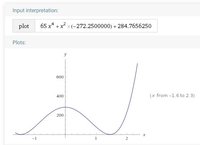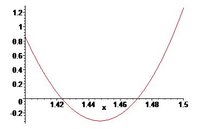… I assume the solutions are a positive and negative real number and a positive and negative imaginary number, correct? …
Hi KQL. The types of solutions depend upon the values of B and K.
… How would you enter the facts [B>0 and K>0] to see the simpler solutions?
I'm not sure that would simplify much. Unfortunately, I don't know the command/syntax for doing that at WolframAlpha. The Computer Algebra System (CAS) used there is based on Mathematica. I've never had much success, while trying to input Mathematica commands I've found online, or when searching WolframAlpha's site for specific commands. I hope someone else here posts specific instructions.
… if I have my number K from experiment then a solution is able to be computed correct? …
If you replace K with a Real number, then the solutions will be symbolic (in terms of B).
To obtain numerical solutions, you'd need to supply values for both K and B. You can experiment, by replacing symbols K and B with numbers. For example, let's see what happens when K=4 and B=1.5 over the x-interval [0,∞].
solve 4=x+x/sqrt(1.5^2-x^2) for x in [0, infinity]
WolframAlpha reports:
x ≈ 1.40002
Well, that's true, but it's not the complete solution. I suspect the CAS is using a root-finding process, and it stops after the first result.
Extra work is needed (for me, at least, because I don't know their language). With those values of K and B, the polynomial is:
plot 65x^4-272.2500000x^2+284.7656250

It appears there are four Real solutions.
My rusty copy of MVR5 (Maple V Release 5, which I also know how to use for only basic stuff) reports:
x ≈ -1.470871014
x ≈ -1.423024947
x ≈ 1.423024947
x ≈ 1.470871014
Here's a zoomed-in graph of the vicinity around the positive results.

If you're interested in getting more details out of WolframAlpha, I'd suggest joining their
users' group and posting questions about what to enter. Alternative sites for posting questions are quora.com and math.stackexchange.com. There might be additional replies posted in this thread, too.
?


